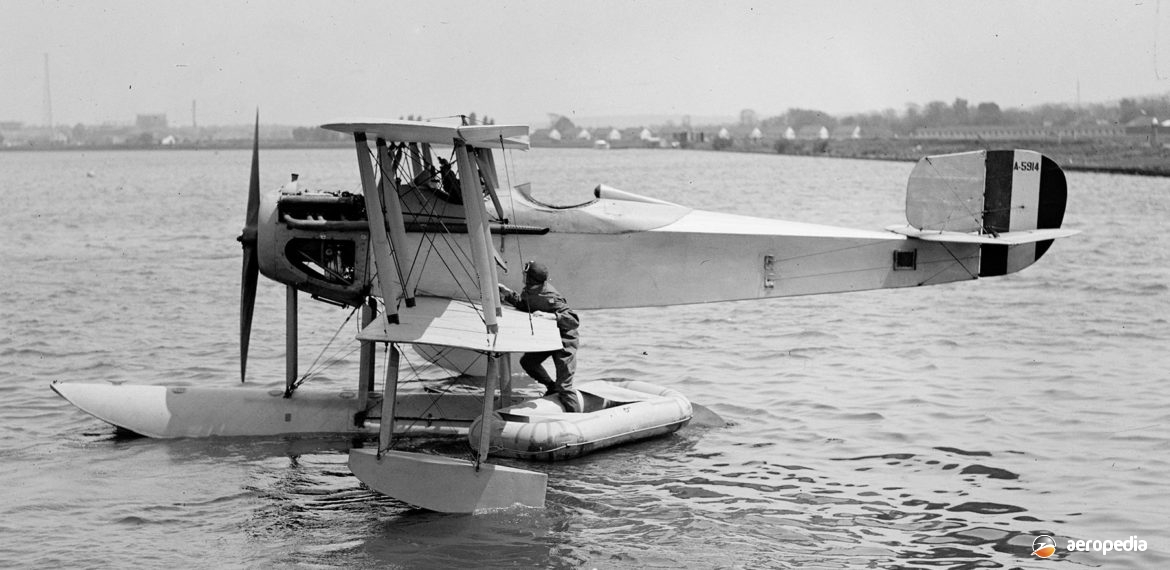Photograph:
Vought VE-7 serial A5914 operated by the American explorer Richard Byrd (Smithsonian Institute)
Country of origin:
United States of America
Description:
General reconnaissance and communications floatplane
Power Plant:
One 134 kw (180 hp) Wright E-2 air-cooled radial engine
Specifications:
- Wingspan: 10.42 m (34 ft 1⅜ in)
- Length: 7.45 m (24 ft 5⅛ in)
- Height: 2.64 m (8 ft 7 in)
- Wing area: 26.43 m² (284.5 sq ft)
- Max speed at sea level: 188 km/h (117 mph)
- Service ceiling: 4,572 m (15,000 ft)
- Climb to 1,524 m (5,000 ft): 5.5 minutes
- Range: 468 km (291 miles)
- Empty weight: 683 kg (1,505 lb)
- Loaded weight: 953 kg (2,100 lb)
Armament:
Two fixed forward firing 7.69 mm (0.303 in) Vickers machine guns, or two 7.62 mm (0.3 in) Browning machine guns
History:
The VE-7H was a general reconnaissance and communications aircraft designed for the US military by Lewis & Vought of Long Island, New York. The prototype first flew in 1918 with a 112 kw (150 hp) Wright-built Hispano-Suiza Model A engine which, at the time, was being produced by the Simplex Automobile Division of the Wright Martin Company. Eventually Lewis & Vought was re-named Chance Vought Corporation after its founder, Chance M Vought. The US Navy procured 128 examples in a number of variants , these having the Wright-Hispano E-2 engine. Many survived into the late 1930s in secondary roles and a number are known to have operated from warships of the US Fleet in the 1920s.
Due to economy and time-saving measures, the VE-7 was not produced in the numbers planned as the Wright-built Hispano engine was installed in the Curtis JN-4D, becoming the JN-4H for training duties. In the early 1920s the US Navy became interested in the VE-7 with the Hispano E engine for training and these were built by Vought and the Naval Aircraft Factory. An improved variant was the VE-9 of which 25 were built for the US Army and 21 for the US Navy. From 1927 many were re-engined with a 164 kw (220 hp) Wright J-5 radial engine.
The seaplane variants of the VE-7 became the standard observation and scouting aircraft of the US Navy fleet in the post-World War I years, being carried on board Battleships and Cruisers and launched by catapult, the aircraft later landing beside the vessel, being recovered to the ship by derrick. A larger fin was usually installed on the floatplanes and this was regularly left in place when the aircraft was converted to landplane configuration for short periods.
On 22 August 1923 the US Navy Cruiser USS Milwaukee arrived in Sydney, NSW, later visiting New Guinea and islands of the South Pacific on a shakedown cruise. On board were two Vought VE-7H observation aircraft, these having a 134 kw (180 hp) Wright E-3 radial engine. The aircraft were usually landed on the sea beside the Cruiser on a single centre float, having stabilising floats under the wing tips, being lifted to and from the sea by the ship’s derrick. These aircraft (serials A-6436 and A-6437) were flown by Lieut R Nyman and Ensign H J McNulty. They made brief flights over Kieta on the island of Bougainville, PNG on 25 September and over Rabaul, New Britain on 9 October.
In July 1925 a further eight Cruisers of the US Navy visited Sydney on a goodwill tour, these vessels being the USS California, USS Mississippi, USS West Virginia, USS Idaho, USS New Mexico, USS Maryland, USS Tennessee and USS Colorado, all of which were equipped with either the Vought UO-1 or VE-7 floatplane. At this time one of the VE-7s capsized on Sydney harbour and sustained some damage, requiring repairs at a shore base. During this visit a few of the floatplanes flew to and made a goodwill visit to the RAAF base at Point Cook, VIC. Photographs show them drawn up on the beach at the base.
Since that time ships of various overseas Navys have visited Australian ports and a number have been equipped with aircraft and helicopters, many aircraft being flown off to visit Australian Naval and Air Force establishments. No VE-7 survives but a replica was built by Vought Aircraft retirees for a museum.

